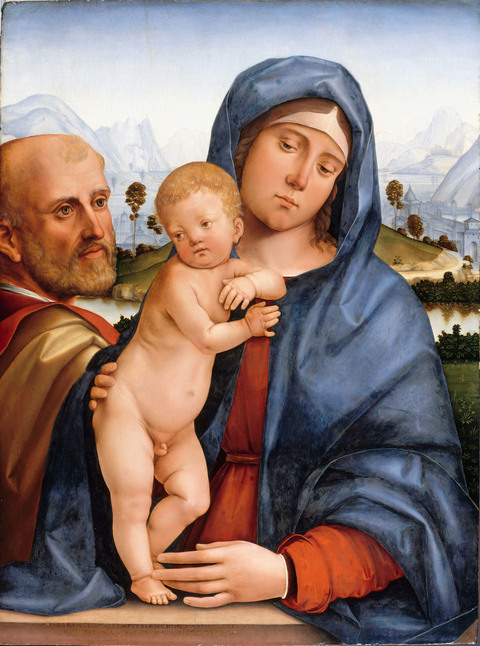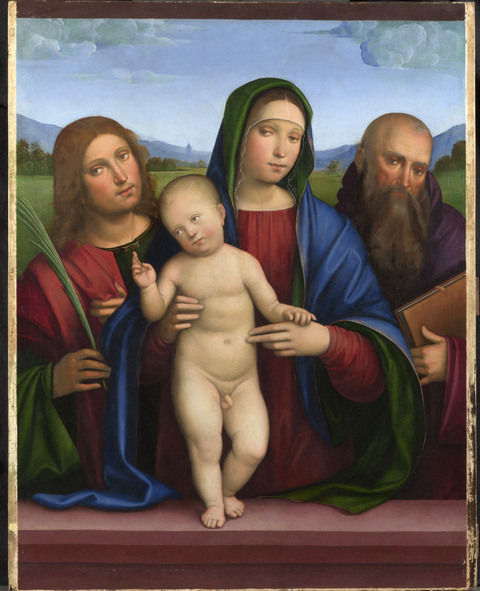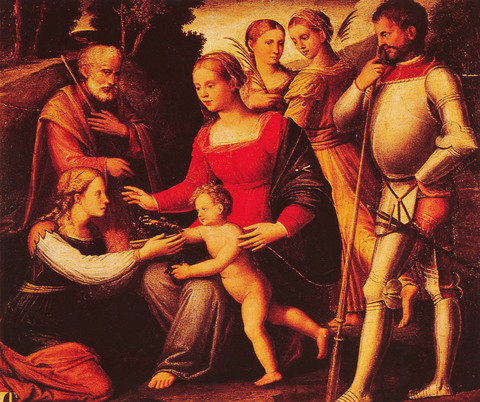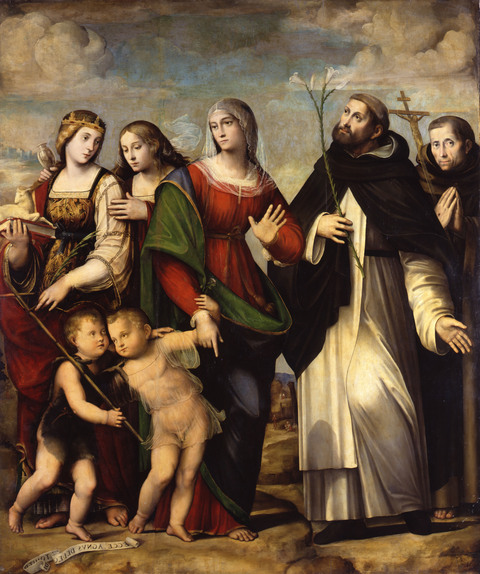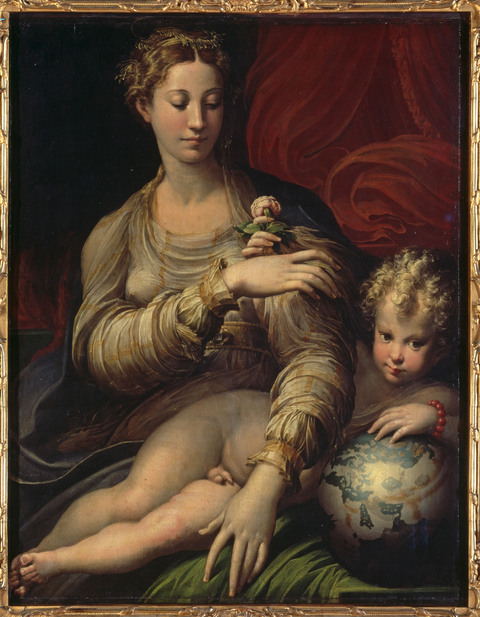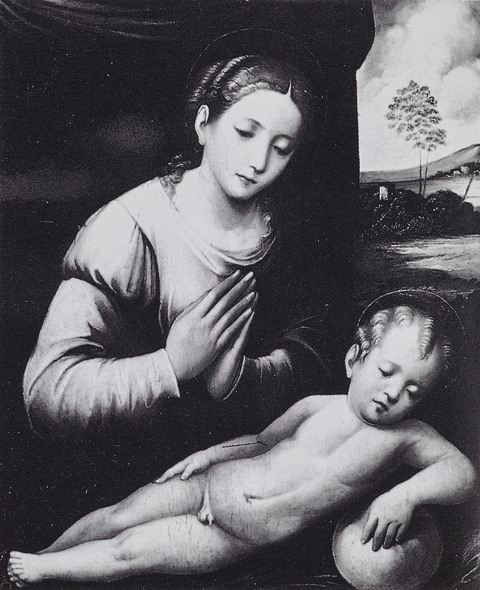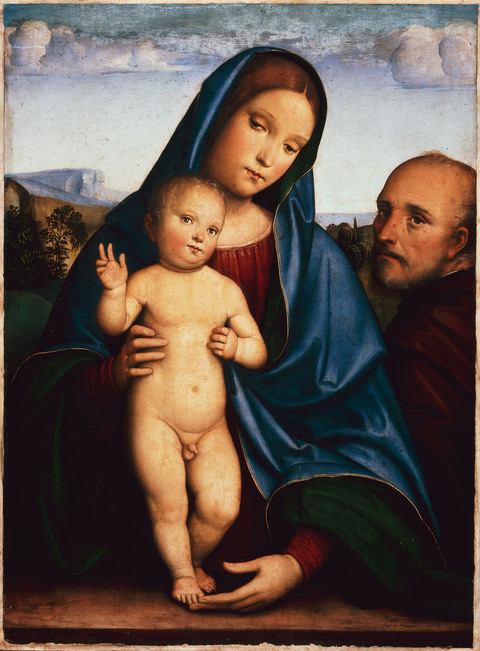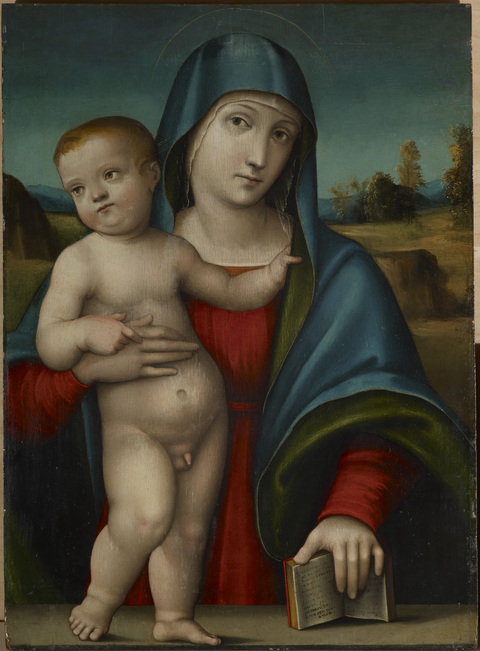Marks, Inscriptions, and Distinguishing Features
None
Entry
This Madonna and Child entered the Clowes Collection as the work of the Italian artist Francesco Francia (about 1450–1517), an attribution that initially was supported by the art historians Mark Roskill and Alastair Ian Fraser. However, in notes to his unpublished “Clowes Collection Catalogue” of 1968, Roskill recorded that art historian Everett Fahy had proposed an attribution to Francesco’s eldest son Giacomo (about 1486–1557), based on similarities between the Clowes painting and several works already ascribed to that artist. Stylistic analysis, however, does not support Giacomo as the artist responsible for the Madonna and Child. A notation on Roskill’s manuscript by Ronda Kasl, then senior curator of painting and sculpture before 1800 at the Indianapolis Museum of Art, reassigns the Clowes painting, correctly I believe, to Giulio Francia (1487–1540).
Giulio was Francesco Francia’s youngest son, who, upon the death of his father in 1517, continued to run the family bottega (workshop) alongside his elderly uncle, Domenico Raibolini, and his older brother Giacomo. When Francesco was alive, he oversaw all work produced in his large and busy studio, and so the paintings created prior to 1517 exhibit a fairly consistent uniformity of figural type and facial physiognomy. This similitude is particularly true of the numerous Virgin and Child paintings created in the Francia bottega, making it difficult to distinguish among early works ascribed to Giacomo, Giulio, or other students. In addition, whoever’s hand was present, such work from the studio was considered to be that of the master. Thus, a brief assessment of Francesco’s work will serve to reveal, through comparison, differences in the style of the two brothers.
Born Francesco di Marco di Giacomo Raibolini in Bologna, the artist apparently adopted his surname “Francia” from the goldsmith Duc, with whom he had apprenticed. This practice was not unusual at the time. Vasari mentions that Sandro Botticelli (1444/1445–1510) adopted his last name thus, and Giulio Romano (1499–1546) named his son “Raffaello” after his master, Raphael (1483–1520). The Raibolini family was an old and respected one in Bologna, and members had served in the city’s government. Early fourteenth-century records reveal that the family held land within the commune of Zola Predosa, approximately seven miles west of Bologna. By the time of Francesco’s birth in about 1450, the Raibolini finances appear to have been in decline and the family sold some of their land as a result.
Francesco’s father, Marco di Giacomo Raibolini, was a woodcarver. The young Raibolini had a talent for metalwork, which resulted in his placement with a goldsmith. Francesco achieved renown in artistic circles, as well as a measure of financial stability, as a goldsmith and minter to the Bentivoglio, wealthy Bolognese autocrats. He joined the Goldsmith’s Guild on 10 September 1482 and become the Master of the Guild within a year.
Not content to restrict himself to metalwork, Francesco began painting in about 1485. By 1490, his paintings were receiving praise, which indicates that he quickly gained facility in that medium. Among his works are altarpieces, mainly in Bologna and the surrounding area, including Parma, Modena, Ferrara, and Lucca. Francia and his workshop also produced three-quarter-length paintings of the Virgin and Child, often with an accompanying saint. Given the smaller, more personal size of those works, they were likely intended for private devotional use in the home. The number of extant paintings of this type attributed to Francesco Francia and his workshop suggests that his bottega was one of main purveyors of such work in Bologna.
Devotional practices in the Northern Italian Renaissance home have been attributed to two main sources of inspiration: Byzantine icons, which some members of the elite collected, and the preaching of the Franciscans, who promoted the devotional lessons of St. Francis. The piety of a Renaissance wife was, after chastity, the most valued trait; a patrician woman, however, could only leave her home in the company of a male relative or an older female chaperone. Because of this restriction, an area within the home for quiet contemplation and prayer was important, particularly for those occasions when a suitable companion was not available to escort the females to church services. Devotional paintings in the home, then, served as points of focus for solitary and family prayer.
Home altars or devotional areas were not restricted to women; the zibaldone (recorded recollections) of Giovanni Morelli, a Florentine, proves that men employed home devotional aids to guide their religious observances both privately and alongside that of their wives. Morelli’s account reveals that personal devotional practices were not limited to silent prayer but included expressions of remorse and grief in the most physical and audible ways. Mourning the death of his son, whom he believed to be trapped in purgatory, Morelli addressed each of the saints represented on his tavola (painted panel); he kissed and touched it, carried it, read portions of the Gospels and prayed and sang psalms to it—all while within close proximity to the painting. Morelli also varied his physical position while undertaking his ceremonies; he kneeled and, at times, even laid prostrate before it.
In addition to serving as a focus for private contemplation, domestic altars played a role in childrearing. Paintings and other devotional objects, such as carved representations of the Infant Christ, afforded a mother the opportunity to introduce her children to stories of the saints and to instruct them on proper comportment in church. Dominican friar Giovanni Dominici instructed the faithful to “make a little altar or two in the house…. [The children] may be occupied in making garlands of flowers and greens with which to crown Jesus or to decorate the picture of the Blessed Virgin…they may be dressed in surplices as acolytes, sing as well as they know how…and be brought to the church sometimes."
The Clowes
Madonna and Child follows a compositional format found in Francesco Francia’s mature paintings, such as the Bianchini
Holy Family (fig. 1) and
Virgin and Child with Two Saints (fig. 2). The Christ child stands upon a parapet to the proper right of his mother, who tenderly supports him with her hand about his waist. She stands behind the wall, indicating her important but supporting role in the salvation of humankind. The infant Jesus occupies a liminal space; he is neither in the viewer’s world nor in the space of his mother. The placement and nudity of the child are carefully orchestrated—the stone parapet acts as a bridge between the divine and earthly realms, concomitantly referencing his sarcophagus and his future death and resurrection. Thus, the Christ child is both infant and sacrificed savior, reminding the viewer of the Nativity, Crucifixion, and Resurrection narratives.
Figure 1: Francesco Francia (about 1450–1517), The Holy Family, about 1485/1490, oil on poplar wood, 21-47/64 × 16-9/64 in. Photograph © bpk Bildagentur/ Gemäldegalerie der Staatlichen Museen zu Berlin–Preußischer Kulturbesitz/Jörg P. Anders/Art Resource, NY. Gemäldegalerie, Staatliche Museen, Berlin, Inv. 125.
Figure 1: Francesco Francia (about 1450–1517), The Holy Family, about 1485/1490, oil on poplar wood, 21-47/64 × 16-9/64 in. Photograph © bpk Bildagentur/ Gemäldegalerie der Staatlichen Museen zu Berlin–Preußischer Kulturbesitz/Jörg P. Anders/Art Resource, NY. Gemäldegalerie, Staatliche Museen, Berlin, Inv. 125.
Figure 2: Francesco Francia (about 1450–1517), The Virgin and Child with Two Saints, about 1500–1510, oil on wood, 30-3/4 × 24-31/64 in. Photograph © National Gallery, London / Art Resource, NY. National Gallery, London, Bought, 1860, NG638.
Figure 2: Francesco Francia (about 1450–1517), The Virgin and Child with Two Saints, about 1500–1510, oil on wood, 30-3/4 × 24-31/64 in. Photograph © National Gallery, London / Art Resource, NY. National Gallery, London, Bought, 1860, NG638.
Compositionally, the figures are balanced through the two gentle curves created by the body of the infant, which curves gently to the left, and the Madonna’s head, which inclines in the opposite direction. They are situated before a nondescript landscape that is typical of the work produced in the school of Francia but which lacks the nuances of the master’s hand. Francesco was known for his meticulous refinement that was sometimes compared to that of Flemish artists. The Clowes panel lacks the details commonly found in the landscapes of the senior Francia’s work: a steeple in the distance, a small village behind the protagonists, or the tall spindly trees that often balanced the inclined heads of the saints.
The Virgin not only supports her son, she also holds open a small, red prayer book, the pages of which are painted to appear as though gilt-edged. The volume, held upright in the Madonna’s proper left hand, is likely a book of hours or similar prayer book. Books of hours included calendars, which recorded daily and monthly observances and religious feast days. Extant samples of such prayer manuals underscore the daily, if not hourly, religious practices held in the home that were supported by domestic devotional objects. The volume is open to an inscription, heavily abraded, which, if from the Virgin’s prayer, the Magnificat, may suggest a concurrently private and communal religious activity. The Magnificat was intended to be recited in the evening, which explains the preponderance of Madonna imagery hung in bedrooms. Family members recited this prayer before retiring, a private experience that most Tuscan households undertook in a mass “action."
The parapet that restricts the Virgin from entering the viewer’s space equally bars the observer from the space she inhabits. The visual trope of the Madonna supporting her son on a stone ledge remained popular in the Francia workshop under the guidance of Giacomo and Giulio. They borrowed this format from their father; however, art historian Nicosetta Roio notes that their paintings lack the subtlety and soft blending of color that Vasari ascribed to the mature work of the elder Francia. Both Roio and Vasari’s observations not only pinpoint Francesco’s competence with color but also his ability to gracefully transition from one form to another. Despite the initial misattribution of many of Giacomo and Giulio Francia’s paintings to their father, these smooth transitions are notably absent from many of the workshop compositions produced after Francesco’s death. Roio attests that the figures in paintings by Giacomo and Giulio exhibit immobile faces and a rigid quality. While this may be an apt description of much of their work, beautifully orchestrated passages of paint can be found in many of their co-creations. Giacomo and Giulio worked together on numerous compositions, each perhaps balancing the aesthetic weakness of the other. Occasionally, it is difficult to discern the separate “hands” of the siblings in these compositions, which were created after their father’s death. The issue of attribution is also hampered by the fact that both sons adopted the nickname of “Francia,” used by their father, and thus commonly signed their works “IF” or “I. Francia."
As Giacomo Francia’s style developed, he continued to present stiff figures and, at times, awkward arrangements that the younger Giulio, it appears, was able to shed. Giacomo’s saints have round, almost bloated faces, which Roio suggests may stem from the late work of his father Francesco.
A clear example of Giacomo’s stouter physiognomy is visible in his
Holy Family with St. Dorothea, Two Martyred Saints, and St. Longino (fig. 3). Conversely, the figural style of Giulio Francia is more linear, and in such paintings as
Madonna and Child with Infant St. John, St. Francis, St. Dominic, Mary Magdalene, and St. Agnes (fig. 4), he often exhibits a greater mastery of compositional complexity than does his older brother.
Figure 3: Giacomo Francia (Italian, about 1486–1557), Holy Family with St. Dorothea, Two Martyred Saints, and St. Longino, about 1520–1530, oil on poplar, about 78-7/10 × 67 in. Whereabouts unknown.
Figure 3: Giacomo Francia (Italian, about 1486–1557), Holy Family with St. Dorothea, Two Martyred Saints, and St. Longino, about 1520–1530, oil on poplar, about 78-7/10 × 67 in. Whereabouts unknown.
Figure 4: Giulio Francia (Italian, 1487–1540), Madonna and Child with Infant St. John, St. Francis, St. Dominic, Mary Magdalene, and St. Agnes, about 1527–1530, oil on poplar wood, 78-47/64 × 66-59/64 in. Photograph © bpk Bildagentur/ Gemäldegalerie der Staatlichen Museen zu Berlin–Preußischer Kulturbesitz/Jörg P. Anders/Art Resource, NY. Gemäldegalerie, Staatliche Museen, Berlin, Inv. 281.
Figure 4: Giulio Francia (Italian, 1487–1540), Madonna and Child with Infant St. John, St. Francis, St. Dominic, Mary Magdalene, and St. Agnes, about 1527–1530, oil on poplar wood, 78-47/64 × 66-59/64 in. Photograph © bpk Bildagentur/ Gemäldegalerie der Staatlichen Museen zu Berlin–Preußischer Kulturbesitz/Jörg P. Anders/Art Resource, NY. Gemäldegalerie, Staatliche Museen, Berlin, Inv. 281.
Giulio’s figural linearity alludes to the impact that the work of Mannerist artist Girolamo Francesco Maria Mazzola (1503–1540), better known as Parmigianino, had on the stylistic direction of both Francia siblings. Parmigianino’s stay in Bologna coincided with the Sack of Rome (1527–1530); the artist had fled the Eternal City as it was invaded by the imperial soldiers of the Holy Roman Emperor. Therefore, it was in Bologna that Parmigianino created several of his best works, including
Madonna of the Rose (fig. 5) and
Madonna with St. Margaret and Other Saints (1528, Bologna, Pinacoteca nazionale).
While Giacomo shed Parmigianino’s influence fairly quickly after his exposure to it, Giulio appears to have been affected by the work of the visiting artist to a deeper level: Giulio based his
Madonna with the Sleeping Infant Christ (fig. 6) on Parmigianino’s
Madonna of the Rose. Both panels portray a Christ child who reclines against an orb, while the Virgin Mary stands behind her son. The orb represents the Earth, and Christ’s pose above it symbolizes Christianity’s triumph over paganism. Giulio did not slavishly copy Parmigianino’s composition; he introduced several intriguing alterations in his rendition, including his decision to portray the Infant Christ in repose rather than awake and active. He also elected to pose his holy mother and son before a window that opens on a vista above the baby’s head.
Figure 5: Parmigianino (Italian, 1503–1540), Madonna of the Rose, about 1530, oil on poplar wood, 42-29/32 × 34-27/32 in. Photo credit: bpk Bildagentur / Art Resource, NY. Gemäldegalerie Alte Meister, Staatliche Kunstsammlungen, Dresden, Gal No. 161.
Figure 5: Parmigianino (Italian, 1503–1540), Madonna of the Rose, about 1530, oil on poplar wood, 42-29/32 × 34-27/32 in. Photo credit: bpk Bildagentur / Art Resource, NY. Gemäldegalerie Alte Meister, Staatliche Kunstsammlungen, Dresden, Gal No. 161.
Figure 6: Giulio Francia (Italian, 1487–1540), Madonna with the Sleeping Infant Christ, about 1530, oil on panel, 23-15/64 × 19-11/16 in. Whereabouts unknown.
Figure 6: Giulio Francia (Italian, 1487–1540), Madonna with the Sleeping Infant Christ, about 1530, oil on panel, 23-15/64 × 19-11/16 in. Whereabouts unknown.
This brief account of the disparities between the style and aesthetic preferences of the two Francia siblings enables the attribution of the Clowes painting to Giulio Francia. A further assessment of the
Madonna and Child and Francesco Francia’s
Holy Family (fig. 7) is instructive, confirming that the panel was painted by Giulio following the death of his father. Both compositions feature the Madonna supporting her son on a parapet, and in each she inclines her head to her proper left. Despite these obvious similarities, the physiognomy of the Virgin in the Clowes painting is strikingly distinctive; her cheeks are less full than in the Madonna of Francesco’s
Holy Family, and the transition from chin to neck is not handled with the same subtlety exhibited in the panel by the elder Francia. Even more distinctive is the Virgin’s angular nose and almond-shaped eyes, which bear a resemblance to Greco-Byzantine icons and are characteristic of Giulio Francia’s saints.
Figure 7: Francesco Francia (about 1450–1517), Holy Family, 1510, oil on panel, 25-13/64 × 19-3/32 in. Photograph © The Museum of Fine Arts Budapest/Scala/Art Resource, NY. Szépművészeti Múzeum, Budapest, Inv. 4244.
Figure 7: Francesco Francia (about 1450–1517), Holy Family, 1510, oil on panel, 25-13/64 × 19-3/32 in. Photograph © The Museum of Fine Arts Budapest/Scala/Art Resource, NY. Szépművészeti Múzeum, Budapest, Inv. 4244.
In the Clowes Madonna and Child, the Virgin gazes knowingly at the viewer. Giulio’s decision to have her engage directly with the observer recalls the painting’s function as a domestic devotional aid. The Virgin candidly yet gently acknowledges the foreknowledge of her son’s life and imparts this knowledge to the viewer. This direct gaze differs from most of the Virgin and Child imagery produced in the Francia workshop. Most such panels featured a demure Madonna looking down at her son or to the side, while the Infant Christ looks out to engage the individual before the panel, as in Francesco’s Holy Family and Giulio’s Madonna and Child with Saints (Fuipiano, San Giovanni Battista). The Clowes painting reverses the workshop’s apparently “sanctioned” presentation by depicting the Infant Jesus looking not to the viewer but rather diverting his gaze. It is intriguing to ponder what caused this stylistic shift; perhaps it was the result of the artist’s development or conceivably it may reflect a patron’s request. Regardless of impetus, the Virgin’s gaze arrests the observer’s glance and simultaneously guides the eye to her son—the source of salvation.
Author
Chrystine L. Keener
Provenance
Julian Acampora (died 1958), New York;
(John H. Folman Art Gallery, Bronxville, New York) in 1954;
G. H. A. Clowes, Indianapolis, in 1954;
The Clowes Fund, Indianapolis, from 1958–2017, and on long-term loan to the Indianapolis Museum of Art since 1971 (C10038);
Given to the Indianapolis Museum of Art, now the Indianapolis Museum of Art at Newfields, in 2017.
Exhibitions
John Herron Art Museum, Indianapolis, 1959, Paintings from the Collection of George Henry Alexander Clowes: A Memorial Exhibition, no. 24 (as Francesco Francia);
Indiana University Art Museum, Bloomington, 1962, Italian and Spanish Paintings from the Clowes Collection, no. 13;
Allen R. Hite Art Institute, University of Louisville Library, University of Louisville, Louisville, KY, 1964, Italian Painting 1300–1600;
Franklin College, Franklin, IN, 1965, Italian, Flemish, and English Painting 1500–1800: From the Clowes Fund Collection, no. 3.
References
Paintings from the Collection of George Henry Alexander Clowes: A Memorial Exhibition, exh. cat. (Indianapolis: John Herron Art Museum, 1959), no. 24;
Italian and Spanish Paintings from the Clowes Collection, exh. cat. (Bloomington: Indiana University Art Museum, 1962);
Italian Painting 1300–1600, exh. cat. (Louisville, KY: Allen R. Hite Art Institute, University of Louisville Library, University of Louisville, 1964) (reproduced);
Italian, Flemish, and English Painting 1500–1800: From the Clowes Fund Collection, exh. cat. (Franklin, IN: Franklin College, 1965), no. 3;
Mark Roskill, “Clowes Collection Catalogue” (unpublished typed manuscript, IMA Clowes Archive, Indianapolis Museum of Art, Indianapolis, IN, 1968);
A. Ian Fraser, A Catalogue of the Clowes Collection (Indianapolis: Indianapolis Museum of Art, 1973), 22–23 (reproduced);
Anthony F. Janson and A. Ian Fraser, Handbook of European and American Paintings to 1945: Indianapolis Museum of Art (Indianapolis: Indianapolis Museum of Art, 1981), 4 (as Francesco Francia).
Notes
